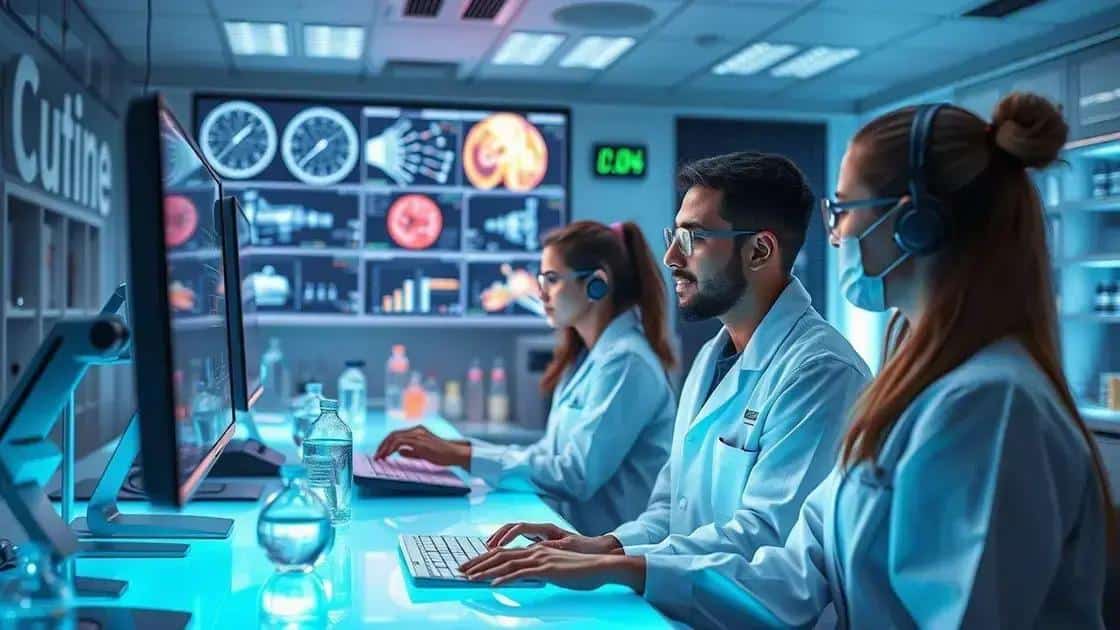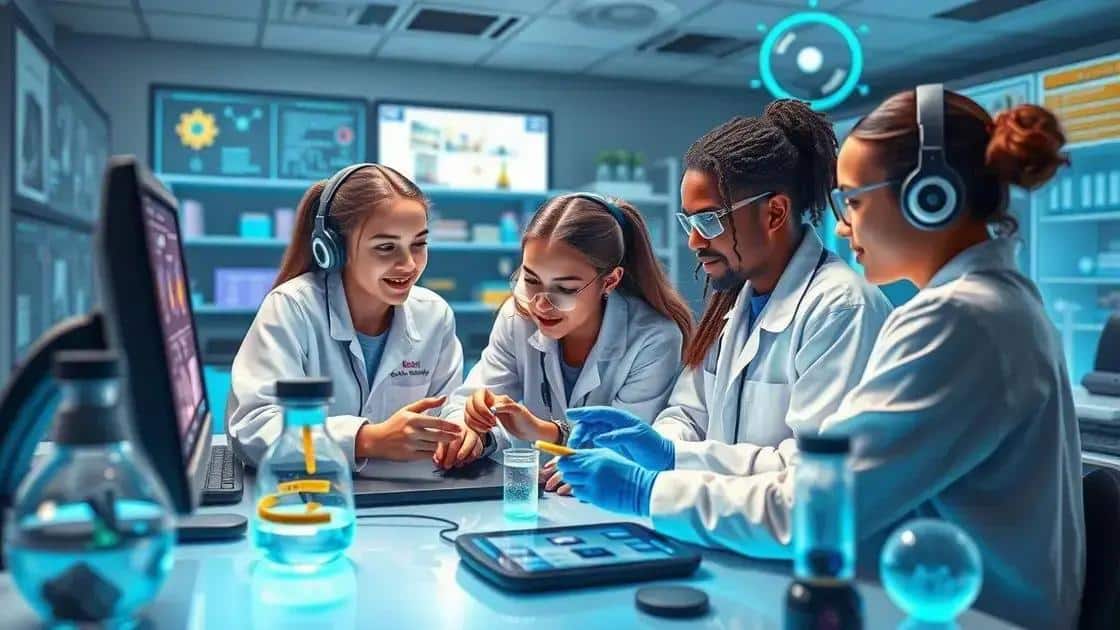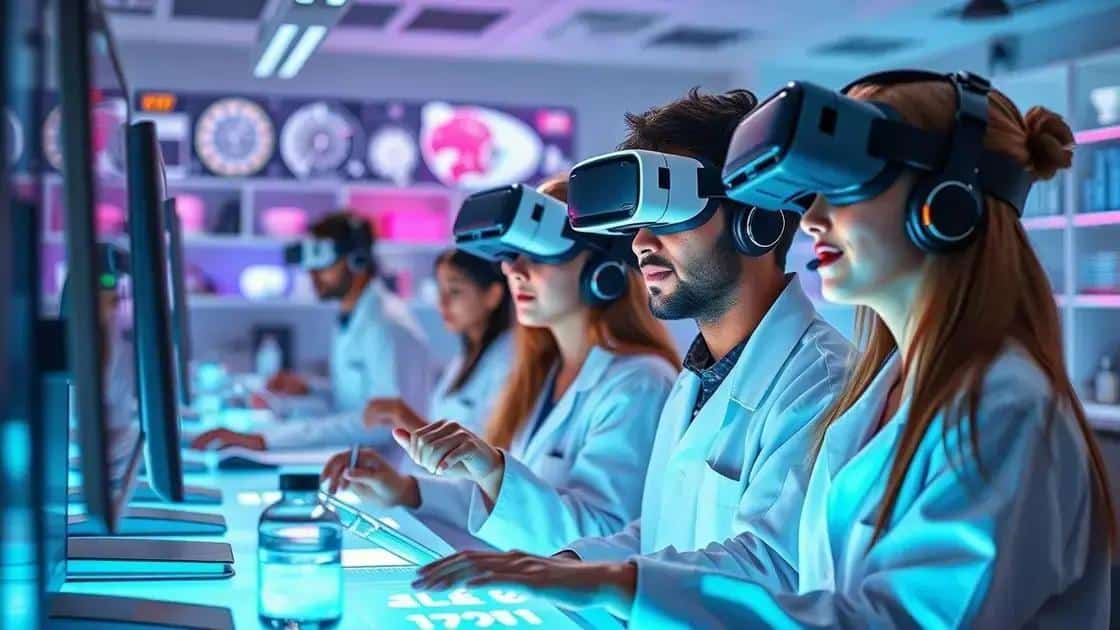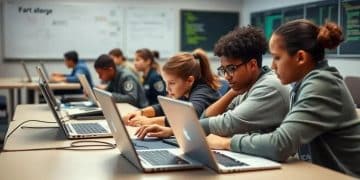Virtual lab simulations trends shaping future education

Virtual lab simulations enhance education by providing interactive, safe, and engaging learning environments, allowing students to conduct experiments and develop critical skills without the limitations of traditional labs.
Virtual lab simulations trends are changing the landscape of education, making practical learning more accessible and interactive. Have you ever wondered how these virtual environments can enhance your understanding of complex subjects? Let’s dive in!
The rise of virtual lab simulations in education
The rise of virtual lab simulations in education represents a significant shift in how students interact with complex subjects. As technology advances, these simulations provide an engaging way to experience hands-on learning without the logistical constraints of physical labs.
What Are Virtual Lab Simulations?
Virtual lab simulations are digital environments that allow students to conduct experiments and practice skills in a controlled setting. They mimic real-world scenarios and can be accessed anywhere, making learning more flexible.
Benefits of Virtual Lab Simulations
Here are a few key benefits that highlight their importance:
- Accessibility: Students can access labs anytime and anywhere.
- Cost-effectiveness: Reduces the need for expensive equipment and materials.
- Safety: Students can conduct experiments without the risk of physical harm.
Furthermore, virtual simulations nurture problem-solving skills and encourage critical thinking. They allow learners to explore concepts that might be dangerous or impractical to try in real life. For example, chemistry students can mix chemicals without the fear of reactions going awry.
The interactive nature of these simulations helps maintain student attention, making learning more enjoyable. As students manipulate variables and observe outcomes in real-time, they gain a deeper understanding of the material.
Examples of Virtual Lab Simulations
There are various platforms offering unique virtual lab environments. Here are a few notable examples:
- Labster: Provides a range of science labs for students to explore.
- PhET: Offers interactive simulations for physics, chemistry, and math.
- ExploreLearning Gizmos: Features math and science simulations.
In summary, the rise of virtual lab simulations is transforming education by enhancing access to learning, promoting engagement, and providing safe environments for exploration. As the adoption of these technologies grows, students will benefit from a deeper understanding of complex subjects while enjoying the learning process.
Benefits of virtual lab simulations for students

Virtual lab simulations offer numerous benefits that enhance the learning experience for students. These digital environments allow learners to engage in practical experiments and simulations without the constraints of physical labs.
Increased Engagement
One of the main advantages of virtual lab simulations is that they boost student engagement. When learners can interact with a digital environment, they often find the experience more enjoyable. This interaction can lead to a deeper interest in the subject matter.
Safe Learning Environment
Another significant benefit is the safety they provide. In a virtual lab, students can conduct experiments that might be dangerous in a real-world setting. They can test hypotheses and learn from mistakes without the risk of injury or accidents. This aspect encourages exploration and creativity.
Flexibility and Accessibility
With virtual simulations, students enjoy greater flexibility in their studies. They can access labs at any time and from anywhere with an internet connection. This accessibility is particularly beneficial for students who may have scheduling conflicts or live in remote areas.
- Cost-effectiveness: Virtual labs eliminate the need for expensive materials.
- Diverse Learning Opportunities: Students can explore a wide range of disciplines through various simulations.
- Instant Feedback: Many simulations provide immediate results, allowing students to assess their understanding quickly.
These elements contribute to a rich learning experience, making it easier for students to grasp complex topics. Additionally, they often encourage collaboration among peers, as students can work together in a shared digital space, enhancing teamwork skills.
By incorporating virtual lab simulations into their education, students not only gain hands-on experience but also develop critical thinking and problem-solving skills. As they navigate these digital environments, they prepare themselves for future challenges in the sciences and other fields.
How virtual lab simulations enhance engagement
Virtual lab simulations play a crucial role in enhancing student engagement in the learning process. These interactive environments allow students to dive into experiments and complex scenarios in an exciting way.
Interactive Learning
One of the primary ways virtual lab simulations engage learners is through interactivity. Students can manipulate variables and see the outcomes in real-time, which sparks curiosity and a desire to explore further. This hands-on approach makes the learning experience feel more relevant and impactful.
Gamified Elements
Many virtual labs incorporate gamified elements, making the process fun. Features like points, badges, and challenges motivate students to participate actively. This playful aspect can lead to increased time spent on learning materials, further reinforcing the concepts taught in classes.
Visual Learning
Visual learning is another benefit of virtual simulations. By providing graphs, charts, and animated scenarios, these tools cater to different learning styles. For students who struggle with traditional lectures, this visual representation can significantly boost understanding and retention.
- Real-world applications: Simulations often model real-world situations, making learning applicable.
- Collaboration: Many platforms allow for group work, enhancing teamwork skills.
- Immediate feedback: Instant results help students learn from their actions quickly.
Furthermore, virtual lab simulations encourage students to ask questions and seek answers while exploring the digital environment. This inquisitive mindset is essential for deep learning and fosters a love for science and experimentation.
Overall, by integrating virtual lab simulations into education, schools can create a more engaging atmosphere that motivates students to learn actively. This transformation in education not only makes classes more enjoyable but also helps cultivate lifelong learners who are curious about the world around them.
Future predictions for virtual lab simulations

The future of virtual lab simulations looks promising as technology continues to evolve. These digital environments are expected to play an even larger role in education, transforming how students learn in various fields.
Integration of Advanced Technologies
One significant trend is the increased integration of advanced technologies such as artificial intelligence (AI) and virtual reality (VR). These technologies can create more immersive experiences, allowing students to feel as though they are truly in a laboratory setting. For instance, AI can adapt simulations based on individual learning styles, providing personalized feedback.
Collaborative Learning Environments
Future simulations are likely to focus more on collaboration among students. With the rise of online learning, virtual labs can provide opportunities for teamwork and problem-solving in real-time. Students from different locations can come together in a digital lab, sharing their findings and learning from one another.
- Expansion Across Disciplines: Virtual lab simulations will extend beyond science and math, reaching fields like art and humanities.
- Accessibility Improvements: More schools will adopt these technologies, making quality education reachable for all.
- Gamification Features: Expect more gamified elements to keep students engaged and motivated during their learning.
As educational institutions recognize the benefits, the implementation of virtual lab simulations will increase. This will not only improve teaching methods but also foster a more dynamic learning atmosphere. Schools may even partner with tech companies to create specialized simulations tailored to current industry needs.
Moreover, the evaluation and assessment methods of these virtual labs will evolve. Educators will use analytics generated by simulations to track students’ progress, helping tailor instruction to meet their needs. This data-driven approach will enhance the overall learning experience and outcomes, making education more effective.
FAQ – Frequently Asked Questions about Virtual Lab Simulations
What are virtual lab simulations?
Virtual lab simulations are digital environments that replicate real-world labs, allowing students to conduct experiments and learn hands-on skills without physical constraints.
How do virtual lab simulations enhance student engagement?
They make learning interactive by allowing students to manipulate variables and see real-time results, which keeps them actively involved and encourages exploration.
What benefits do virtual lab simulations provide for safety?
These simulations eliminate the risk of physical harm, enabling students to safely experiment with potentially dangerous scenarios in a controlled environment.
What trends can we expect for virtual lab simulations in the future?
Future trends include the integration of AI for personalized learning experiences, increased collaboration among students, and more immersive technologies like virtual reality.






